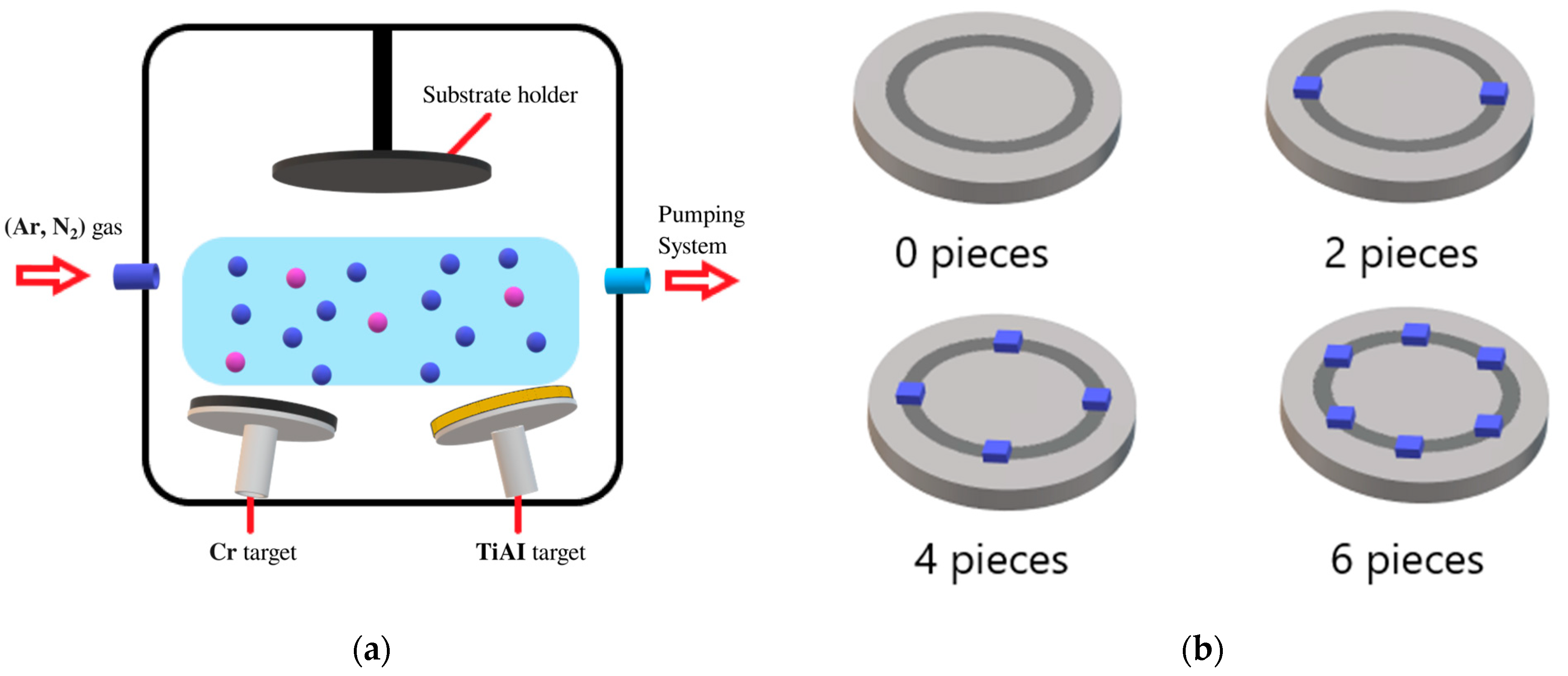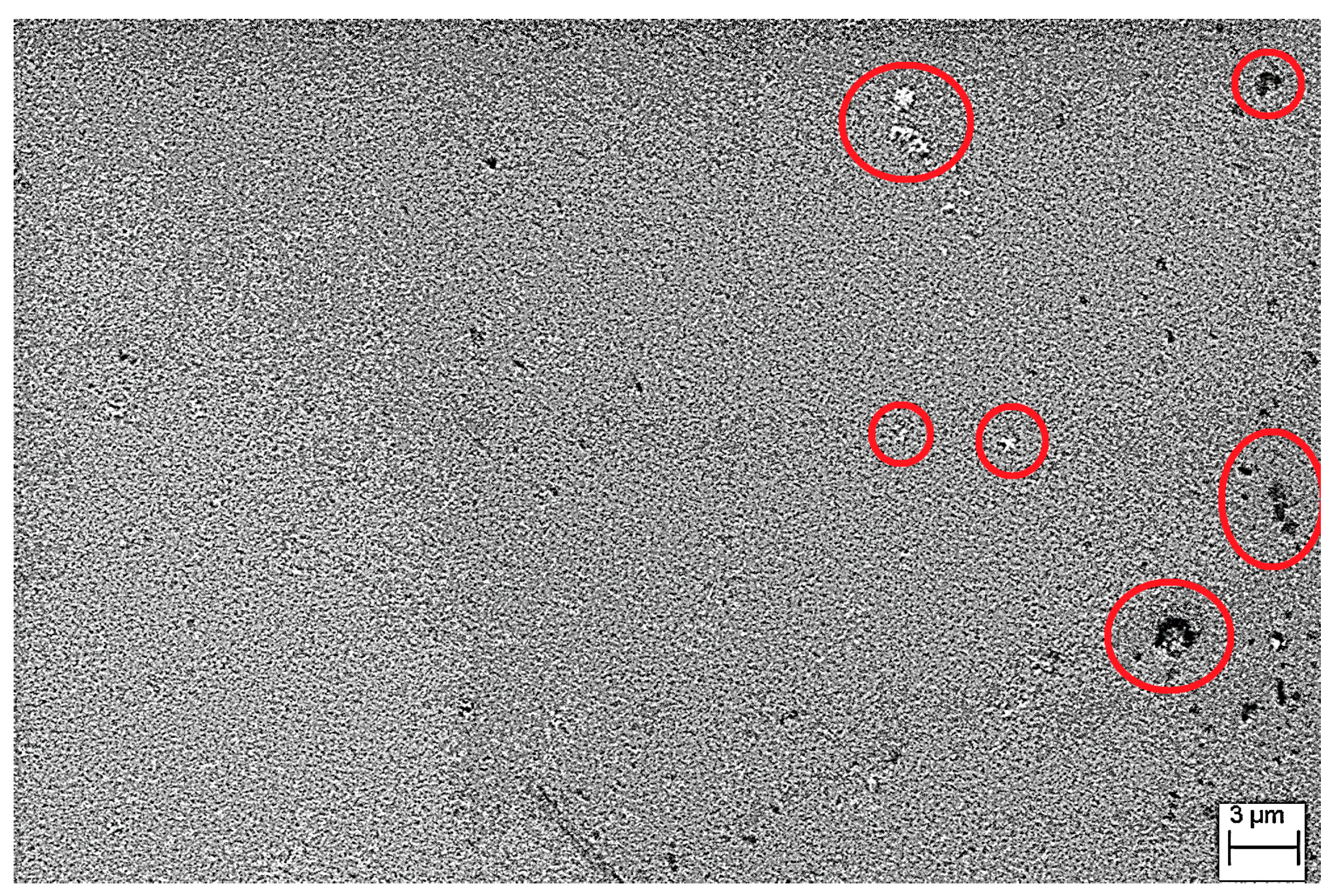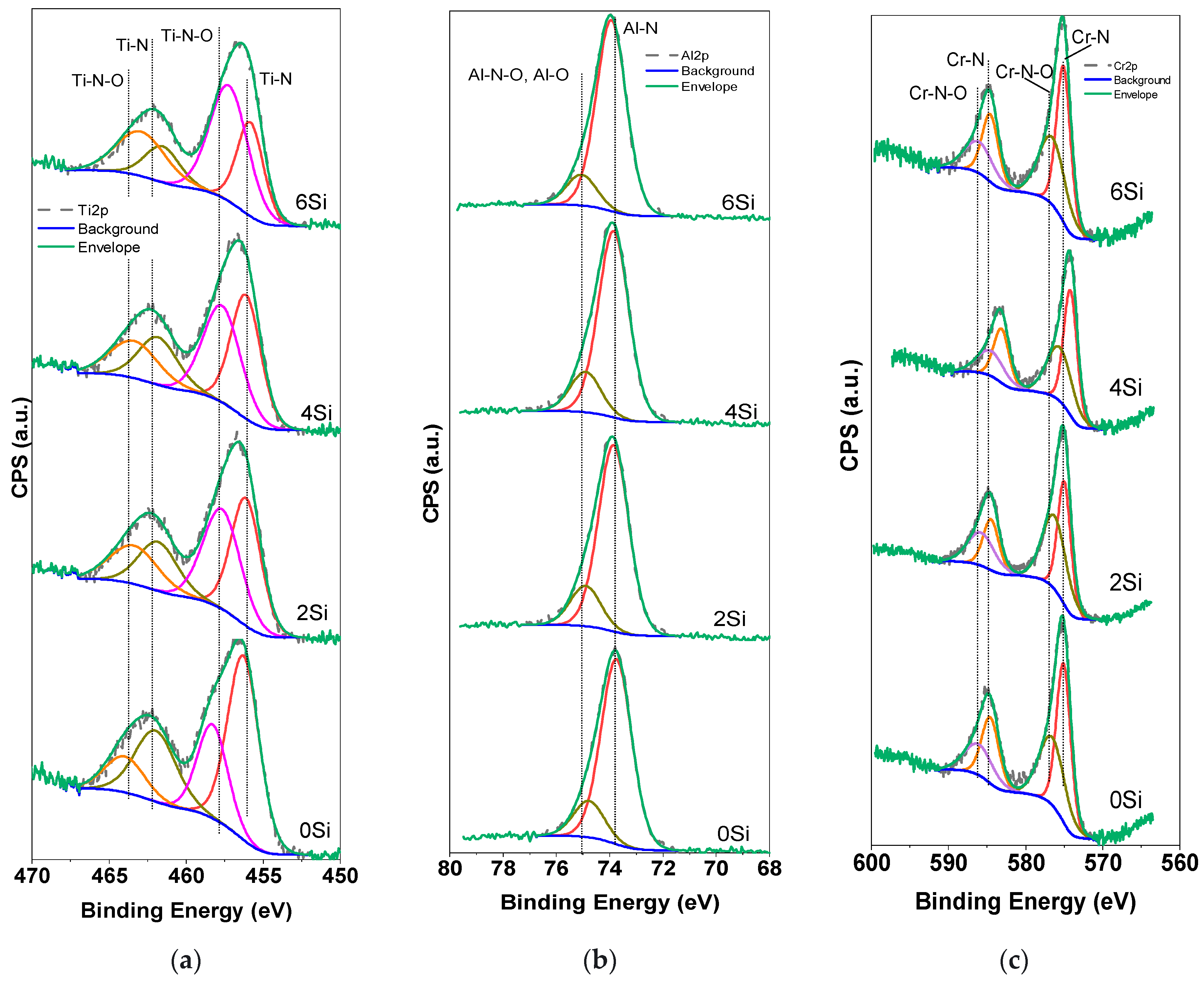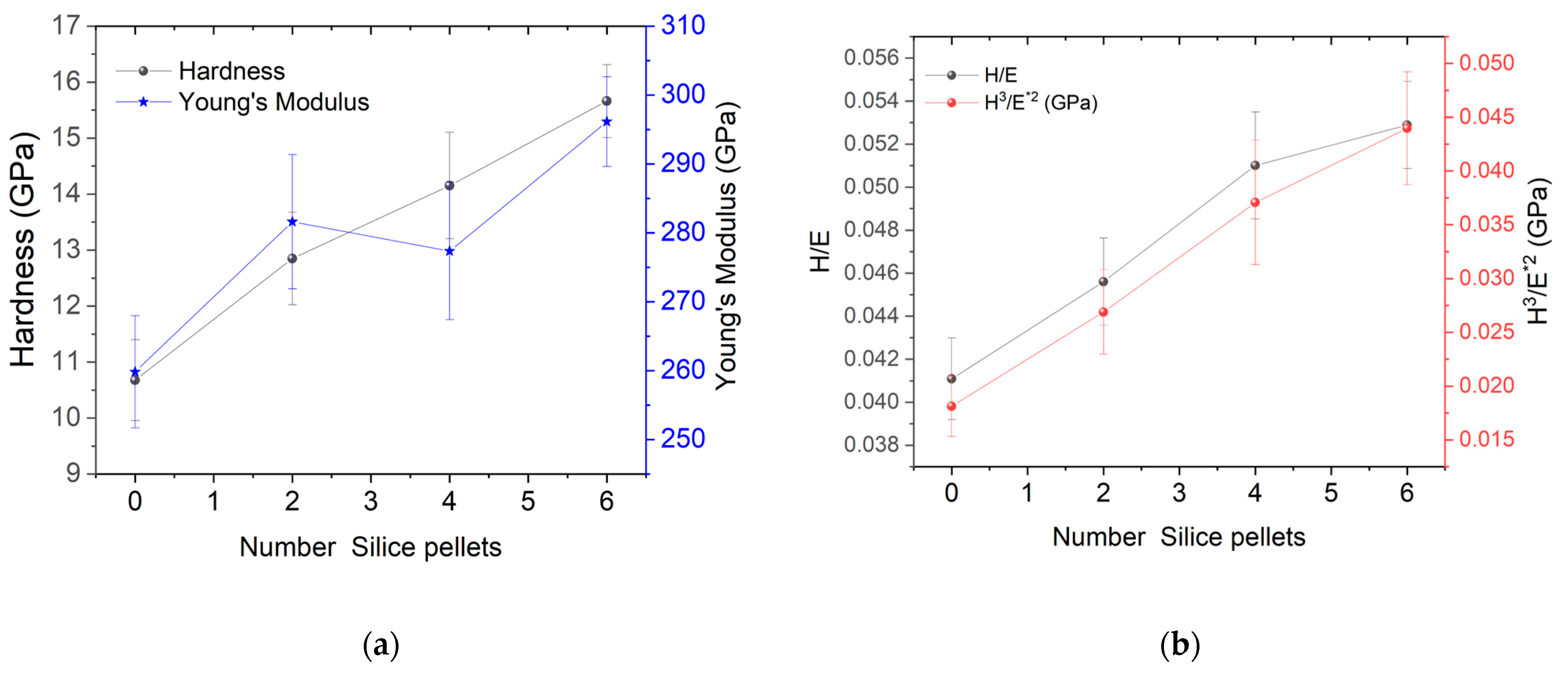Influence of Si Addition on the Chemical and Tribological Performance of TiAlCrN Coating Deposited by Co-Sputtering
Abstract
:1. Introduction
2. Materials and Methods
3. Results
3.1. Structure and Morphology
3.2. Chemical Analysis
3.3. Mechanical Properties
3.4. Wear Behavior
4. Conclusions
Author Contributions
Funding
Data Availability Statement
Acknowledgments
Conflicts of Interest
References
- Baptista, A.; Silva, F.J.G.; Porteiro, J.; Míguez, J.L.; Pinto, G.; Fernandes, L. On the Physical Vapour Deposition (PVD): Evolution of Magnetron Sputtering Processes for Industrial Applications. In Procedia Manufacturing; Elsevier B.V.: Amsterdam, The Netherlands, 2018; pp. 746–757. [Google Scholar] [CrossRef]
- Ardila-Tellez, L.-C.; Orozco-Hernandez, G.; Estupiñan-Mongui, F.; Moreno-Téllez, C.-M.; Olaya-Florez, J.-J. Review of Nitride-Based Multifunctional PVD-Deposited Coatings. Rev. Científica 2023, 46, 162–176. [Google Scholar] [CrossRef]
- Grzesik, W.; Zalisz, Z.; Nieslony, P. Friction and wear testing of multilayer coatings on carbide substrates for dry machining applications. Surf. Coat. Technol. 2002, 155, 37–45. [Google Scholar] [CrossRef]
- Xiao, B.; Zhang, T.F.; Guo, Z.; Li, Z.; Fan, B.; Chen, G.; Xiong, Z.; Wang, Q. Mechanical, oxidation, and cutting properties of AlCrN/AlTiSiN nano-multilayer coatings. Surf. Coat. Technol. 2022, 433, 128094. [Google Scholar] [CrossRef]
- Kumar, T.S.; Prabu, S.B.; Manivasagam, G. Metallurgical Characteristics of TiAlN/AlCrN Coating Synthesized by the PVD Process on a Cutting Insert. J. Mater. Eng. Perform. 2014, 23, 2877–2884. [Google Scholar] [CrossRef]
- Sousa, V.F.C.; Silva, F.J.G.; Alexandre, R.; Fecheira, J.S.; Silva, F.P.N. Study of the wear behaviour of TiAlSiN and TiAlN PVD coated tools on milling operations of pre-hardened tool steel. Wear 2021, 476, 203695. [Google Scholar] [CrossRef]
- Günay, M.; Korkmaz, M.E.; Yaşar, N. Performance analysis of coated carbide tool in turning of Nimonic 80A superalloy under different cutting environments. J. Manuf. Process. 2020, 56, 678–687. [Google Scholar] [CrossRef]
- Markopoulos, A.P. Machining Processes; Springer: Berlin/Heidelberg, Germany, 2013; pp. 1–9. [Google Scholar] [CrossRef]
- He, Q.; Paiva, J.M.; Kohlscheen, J.; Beake, B.D.; Veldhuis, S.C. An integrative approach to coating/carbide substrate design of CVD and PVD coated cutting tools during the machining of austenitic stainless steel. Ceram. Int. 2020, 46, 5149–5158. [Google Scholar] [CrossRef]
- Birol, Y.; Isler, D. AlTiN and AlTiON-coated hot work tool steels for tooling in steel thixoforming. Trans. Nonferrous Met. Soc. China 2010, 20, S1022–S1028. [Google Scholar] [CrossRef]
- Kravchenko, Y.O.; Coy, L.; Peplińska, B.; Iatsunskyi, I.; Załęski, K.; Kempiǹski, M.; Beresnev, V.; Konarski, P.; Jurga, S.; Pogrebnjak, A. Nano-multilayered coatings of (TiAlSiY)N/MeN (Me=Mo, Cr and Zr): Influence of composition of the alternating layer on their structural and mechanical properties. J. Alloys Compd. 2018, 767, 483–495. [Google Scholar] [CrossRef]
- Siwawut, S.; Saikaew, C.; Wisitsoraat, A.; Surinphong, S. Cutting performances and wear characteristics of WC inserts coated with TiAlSiN and CrTiAlSiN by filtered cathodic arc in dry face milling of cast iron. Int. J. Adv. Manuf. Technol. 2018, 97, 3883–3892. [Google Scholar] [CrossRef]
- Das, S.; Guha, S.; Ghadai, R.; Swain, B.P. A comparative analysis over different properties of TiN, TiAlN and TiAlSiN thin film coatings grown in nitrogen gas atmosphere. Mater. Chem. Phys. 2021, 258, 123866. [Google Scholar] [CrossRef]
- Mo, J.L.; Zhu, M.H.; Lei, B.; Leng, Y.X.; Huang, N. Comparison of tribological behaviours of AlCrN and TiAlN coatings—Deposited by physical vapor deposition. Wear 2007, 263, 1423–1429. [Google Scholar] [CrossRef]
- Zhang, F.; Yan, M.; He, J.; Yin, F. Microstructure evolution and wear resistance of nitride/aluminide coatings on the surface of Ti-coated 2024 Al alloy during plasma nitriding. Ceram. Int. 2017, 43, 10832–10839. [Google Scholar] [CrossRef]
- Cota, J.A.C. Estudio de Evolución Microestructural de Una Superaleación Base Ni-Cr-Mo Bajo Diferentes Condiciones Termomecánicas. Ph.D. Thesis, Universidad Autónoma de Nuevo León, San Nicolas de Los Garza, Mexico, 2015. [Google Scholar]
- Veprek, S.; Veprek-Heijman, M.G.J. Limits to the preparation of superhard nanocomposites: Impurities, deposition and annealing temperature. Thin Solid Film. 2012, 522, 274–282. [Google Scholar] [CrossRef]
- Miletić, A.; Panjan, P.; Škorić, B.; Čekada, M.; Dražič, G.; Kovač, J. Microstructure and mechanical properties of nanostructured Ti–Al–Si–N coatings deposited by magnetron sputtering. Surf. Coat. Technol. 2014, 241, 105–111. [Google Scholar] [CrossRef]
- Fox-Rabinovitch, G.; Dosbaeva, G.; Kovalev, A.; Gershman, I.; Yamamoto, K.; Locks, E.; Paiva, J.; Konovalov, E.; Veldhuis, S. Enhancement of Multi-Scale Self-Organization Processes during Inconel DA 718 Machining through the Optimization of TiAlCrSiN/TiAlCrN Bi-Nano-Multilayer Coating Characteristics. Materials 2022, 15, 1329. [Google Scholar] [CrossRef]
- Bobzin, K.; Kalscheuer, C.; Carlet, M.; Hoffmann, D.C.; Bergs, T.; Uhlmann, L. Low-Temperature Physical Vapor Deposition TiAlCrSiN Coated High-Speed Steel: Comparison between Shot-Peened and Polished Substrate Condition. Adv. Eng. Mater. 2022, 24, 2200099. [Google Scholar] [CrossRef]
- Fox-Rabinovich, G.S.; Beake, B.; Yamamoto, K.; Aguirre, M.; Veldhuis, S.; Dosbaeva, G.; Elfizy, A.; Biksa, A.; Shuster, L. Structure, properties and wear performance of nano-multilayered TiAlCrSiYN/TiAlCrN coatings during machining of Ni-based aerospace superalloys. Surf. Coat. Technol. 2010, 204, 3698–3706. [Google Scholar] [CrossRef]
- Joung, Y.-H.; Kang, H.I.; Kim, J.H.; Lee, H.-S.; Lee, J.; Choi, W.S. SiC formation for a solar cell passivation layer using an RF magnetron co-sputtering system. Nanoscale Res. Lett. 2012, 7, 22. [Google Scholar] [CrossRef]
- Estupiñan, F.A.; Moreno, C.M.; Olaya, J.J.; Ardila, L.C. Wear Resistance of TiAlCrSiN Coatings Deposited by Means of the Co-Sputtering Technique. Lubricants 2021, 9, 64. [Google Scholar] [CrossRef]
- Feng, C.; Hu, S.; Jiang, Y.; Wu, N.; Li, M.; Xin, L.; Zhu, S.; Wang, F. Effects of Si content on microstructure and mechanical properties of TiAlN/Si3N4–Cu nanocomposite coatings. Appl. Surf. Sci. 2014, 320, 689–698. [Google Scholar] [CrossRef]
- Chen, L.; Yang, B.; Xu, Y.; Pei, F.; Zhou, L.; Du, Y. Improved thermal stability and oxidation resistance of Al–Ti–N coating by Si addition. Thin Solid Film. 2014, 556, 369–375. [Google Scholar] [CrossRef]
- Chen, J.T.; Wang, J.; Zhang, F.; Zhang, G.; Fan, X.; Wu, Z.; Yan, P. Characterization and temperature controlling property of TiAlN coatings deposited by reactive magnetron co-sputtering. J. Alloys Compd. 2009, 472, 91–96. [Google Scholar] [CrossRef]
- Wang, W.; Zhan, P.; Xie, Z.; Li, Z.; Zhang, Z. Mechanical property improvement by texture control of magnetron co-sputtered Zr–Ti films. J. Appl. Phys. 2014, 115, 043524. [Google Scholar] [CrossRef]
- Zhou, H.; Zheng, J.; Gui, B.; Geng, D.; Wang, Q. AlTiCrN coatings deposited by hybrid HIPIMS/DC magnetron co-sputtering. Vacuum 2017, 136, 129–136. [Google Scholar] [CrossRef]
- Haghiri-Gosnet, A.M.; Ladan, F.R.; Mayeux, C.; Launois, H.; Joncour, M.C. Stress and microstructure in tungsten sputtered thin films. J. Vac. Sci. Technol. A Vac. Surf. Film. 1989, 7, 2663–2669. [Google Scholar] [CrossRef]
- Chen, L.; Moser, M.; Du, Y.; Mayrhofer, P.H. Compositional and structural evolution of sputtered Ti-Al-N. Thin Solid Film. 2009, 517, 6635–6641. [Google Scholar] [CrossRef]
- Chen, H.; Zheng, B.C.; Li, Y.G.; Wu, Z.L.; Lei, M.K. Flexible hard TiAlSiN nanocomposite coatings deposited by modulated pulsed power magnetron sputtering with controllable peak power. Thin Solid Film. 2019, 669, 377–386. [Google Scholar] [CrossRef]
- Jiang, N.; Shen, Y.G.; Mai, Y.W.; Chan, T.; Tung, S.C. Nanocomposite Ti–Si–N films deposited by reactive unbalanced magnetron sputtering at room temperature. Mater. Sci. Eng. B 2004, 106, 163–171. [Google Scholar] [CrossRef]
- Zhang, X.; Ptasinska, S. Growth of silicon oxynitride films by atmospheric pressure plasma jet. J. Phys. D Appl. Phys. 2014, 47, 145202. [Google Scholar] [CrossRef]
- Meškinis, Š.; Tamulevičius, S.; Kopustinskas, V.; Andrulevičius, M.; Guobienė, A.; Gudaitis, R.; Liutvinienė, I. Hydrophobic properties of the ion beam deposited DLC films containing SiOx. Thin Solid Film. 2007, 515, 7615–7618. [Google Scholar] [CrossRef]
- Hasegawa, H.; Ohashi, K.; Tsukamoto, S.; Sato, T.; Suzuki, T. Characterization of quaternary (Cr,Al)N-based films synthesized by the cathodic arc method. Surf. Coat. Technol. 2007, 202, 786–789. [Google Scholar] [CrossRef]
- Gredelj, S.; Gerson, A.R.; Kumar, S.; Cavallaro, G.P. Characterization of aluminium surfaces with and without plasma nitriding by X-ray photoelectron spectroscopy. Appl. Surf. Sci. 2001, 174, 240–250. [Google Scholar] [CrossRef]
- Sui, X.; Li, G.; Jiang, C.; Wang, K.; Zhang, Y.; Hao, J.; Wang, Q. Improved toughness of layered architecture TiAlN/CrN coatings for titanium high speed cutting. Ceram. Int. 2018, 44, 5629–5635. [Google Scholar] [CrossRef]
- Shum, P.W.; Zhou, Z.F.; Li, K.Y.; Shen, Y.G. XPS, AFM and nanoindentation studies of Ti1−xAlxN films synthesized by reactive unbalanced magnetron sputtering. Mater. Sci. Eng. B 2003, 100, 204–213. [Google Scholar] [CrossRef]
- Shimizu, I.; Setsuhara, Y.; Miyake, S.; Kumagai, M.; Ogata, K.; Kohata, M.; Yamaguchi, K. Preparation of aluminum oxide films by ion beam assisted deposition. Surf. Coat. Technol. 2000, 131, 187–191. [Google Scholar] [CrossRef]
- Conde, A.; Cristóbal, A.B.; Fuentes, G.; Tate, T.; de Damborenea, J. Surface analysis of electrochemically stripped CrN coatings. Surf. Coat. Technol. 2006, 201, 3588–3595. [Google Scholar] [CrossRef]
- Milošev, I.; Strehblow, H.-H.; Navinšek, B. Comparison of TiN, ZrN and CrN hard nitride coatings: Electrochemical and thermal oxidation. Thin Solid Film. 1997, 303, 246–254. [Google Scholar] [CrossRef]
- Zhou, Q.G.; Bai, X.D.; Chen, X.W.; Peng, D.Q.; Ling, Y.H.; Wang, D.R. Corrosion resistance of duplex and gradient CrNx coated H13 steel. Appl. Surf. Sci. 2003, 211, 293–299. [Google Scholar] [CrossRef]
- Tang, Y.; Pan, H.; Li, D.Y. Contribution of cold-work to the wear resistance of materials and its limitation—A study combining molecular dynamics modeling and experimental investigation. Wear 2021, 476, 203642. [Google Scholar] [CrossRef]
- Lin, J.; Zhang, X.; Ou, Y.; Wei, R. The structure, oxidation resistance, mechanical and tribological properties of CrTiAlN coatings. Surf. Coat. Technol. 2015, 277, 58–66. [Google Scholar] [CrossRef]
- Chang, Y.Y.; Lai, H.M. Wear behavior and cutting performance of CrAlSiN and TiAlSiN hard coatings on cemented carbide cutting tools for Ti alloys. Surf. Coat. Technol. 2014, 259, 152–158. [Google Scholar] [CrossRef]
- Philippon, D.; Godinho, V.; Nagy, P.M.; Delplancke-Ogletree, M.P.; Fernández, A. Endurance of TiAlSiN coatings: Effect of Si and bias on wear and adhesion. Wear 2011, 270, 541–549. [Google Scholar] [CrossRef]
- Kazlauskas, D.; Jankauskas, V.; Kreivaitis, R.; Tučkutė, S. Wear behaviour of PVD coating strengthened WC-Co cutters during milling of oak-wood. Wear 2022, 498–499, 204336. [Google Scholar] [CrossRef]
- Bobzin, K.; Brögelmann, T.; Kalscheuer, C. Triboactive CrAlN+X hybrid dcMS/HPPMS PVD nitride hard coatings for friction and wear reduction on components. Surf. Coat. Technol. 2017, 332, 452–463. [Google Scholar] [CrossRef]
- Diserens, M.; Patscheider, J.; Lévy, F. Mechanical properties and oxidation resistance of nanocomposite TiN–SiNx physical-vapor-deposited thin films. Surf. Coat. Technol. 1999, 120–121, 158–165. [Google Scholar] [CrossRef]
- Mei, F.; Shao, N.; Hu, X.; Li, G.; Gu, M. Microstructure and mechanical properties of reactively sputtered Ti–Si–N nanocomposite films. Mater. Lett. 2005, 59, 2442–2445. [Google Scholar] [CrossRef]
- Hsu, C.H.; Huang, W.C.; Lee, Y.P.; Ho, W.Y. Effect of nitrogen atmosphere heat treatment on structure and wear behavior of CrAlSiN nanocomposite film. Surf. Coat. Technol. 2017, 320, 230–234. [Google Scholar] [CrossRef]
- Alberdi, A.; Marín, M.; Díaz, B.; Sánchez, O.; Galindo, R.E. Wear resistance of titanium-aluminium-chromium-nitride nanocomposite thin films. Vacuum 2007, 81, 1453–1456. [Google Scholar] [CrossRef]
- Li, J.; Cui, X.; Guan, Y.; Jin, G.; Zheng, W.; Liu, E.; Wan, S.; Shi, Z.; Liu, A. Effect of SiC content on microstructural evolution and tribology properties of laser-clad TiC-reinforced Ti-Al-Si composite coatings. Mater. Today Commun. 2023, 35, 106019. [Google Scholar] [CrossRef]
- Hwang, Y.J.; Hong, S.H.; Kim, Y.S.; Park, H.J.; Jeong, Y.B.; Kim, J.T.; Kim, K.B. Influence of silicon content on microstructure and mechanical properties of Ti-Cr-Si alloys. J. Alloys Compd. 2018, 737, 53–57. [Google Scholar] [CrossRef]
- Zhang, S.; Zhang, X. Toughness evaluation of hard coatings and thin films. Thin Solid Film. 2012, 520, 2375–2389. [Google Scholar] [CrossRef]
- Macías, H.A.; Yate, L.; Coy, L.E.; Aperador, W.; Olaya, J.J. Influence of Si-addition on wear and oxidation resistance of TiWSixN thin films. Ceram. Int. 2019, 45, 17363–17375. [Google Scholar] [CrossRef]








| Parameter | Value(s) |
|---|---|
| Power applied to Cr target (W) | 110 |
| Power applied to TiAl target (W) | 270 |
| Deposit time (min) | 70 |
| Vacuum pressure (mbar) | 5.7 × 10−6 |
| Work pressure (mbar) | 4.0 × 10−3 |
| N2 flux (sccm) | 3.8 sccm |
| Ar flux (sccm) | 14 sccm |
| Substrate temperature (°C) | 300 ± 5 |
| Substrate rotation speed (rpm) | 10 |
| Sample | %Atomic by XPS | ||||||
|---|---|---|---|---|---|---|---|
| C | O | N | Ti | Al | Cr | Si | |
| TiCrAlSiN-0P | 31.38 | 16.31 | 18.93 | 4.10 | 25.37 | 3.91 | ND+ |
| TiCrAlSiN-2P | 26.92 | 13.17 | 20.58 | 5.16 | 28.53 | 5.04 | 0.60 |
| TiCrAlSiN-4P | 36.50 | 14.57 | 18.22 | 3.85 | 22.92 | 3.11 | 0.83 |
| TiCrAlSiN-6P | 19.42 | 15.36 | 24.19 | 5.03 | 29.38 | 5.0 | 1.59 |
Disclaimer/Publisher’s Note: The statements, opinions and data contained in all publications are solely those of the individual author(s) and contributor(s) and not of MDPI and/or the editor(s). MDPI and/or the editor(s) disclaim responsibility for any injury to people or property resulting from any ideas, methods, instructions or products referred to in the content. |
© 2023 by the authors. Licensee MDPI, Basel, Switzerland. This article is an open access article distributed under the terms and conditions of the Creative Commons Attribution (CC BY) license (https://creativecommons.org/licenses/by/4.0/).
Share and Cite
Ardila, L.C.; Dueñas, R.; Orozco, G.; Olaya, J.J.; Ordoñez, A.F.; Moreno, C.M.; Pineda, Y. Influence of Si Addition on the Chemical and Tribological Performance of TiAlCrN Coating Deposited by Co-Sputtering. Crystals 2023, 13, 1666. https://doi.org/10.3390/cryst13121666
Ardila LC, Dueñas R, Orozco G, Olaya JJ, Ordoñez AF, Moreno CM, Pineda Y. Influence of Si Addition on the Chemical and Tribological Performance of TiAlCrN Coating Deposited by Co-Sputtering. Crystals. 2023; 13(12):1666. https://doi.org/10.3390/cryst13121666
Chicago/Turabian StyleArdila, L. C., R. Dueñas, G. Orozco, J. J. Olaya, A. F. Ordoñez, C. M. Moreno, and Y. Pineda. 2023. "Influence of Si Addition on the Chemical and Tribological Performance of TiAlCrN Coating Deposited by Co-Sputtering" Crystals 13, no. 12: 1666. https://doi.org/10.3390/cryst13121666
APA StyleArdila, L. C., Dueñas, R., Orozco, G., Olaya, J. J., Ordoñez, A. F., Moreno, C. M., & Pineda, Y. (2023). Influence of Si Addition on the Chemical and Tribological Performance of TiAlCrN Coating Deposited by Co-Sputtering. Crystals, 13(12), 1666. https://doi.org/10.3390/cryst13121666






